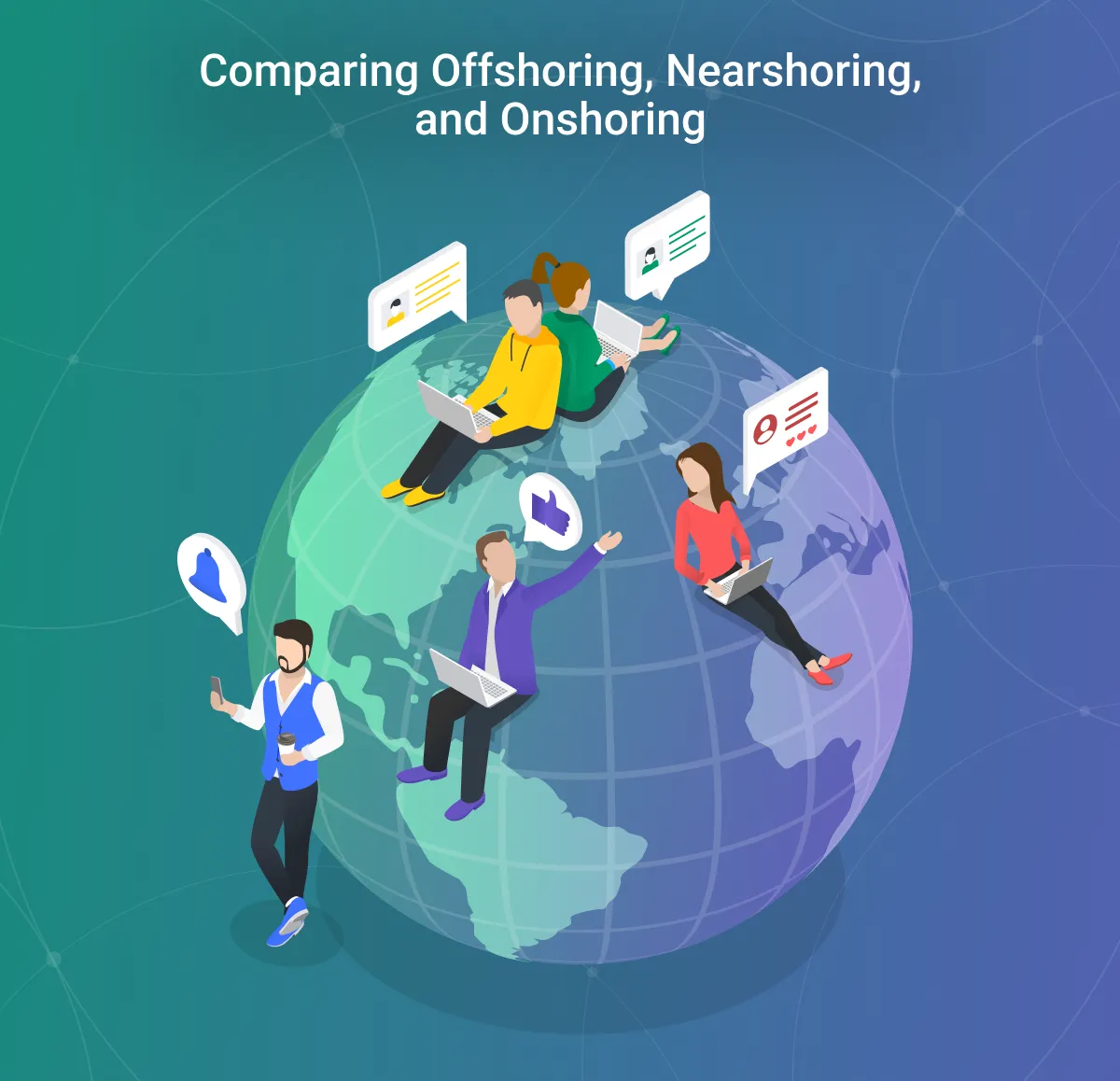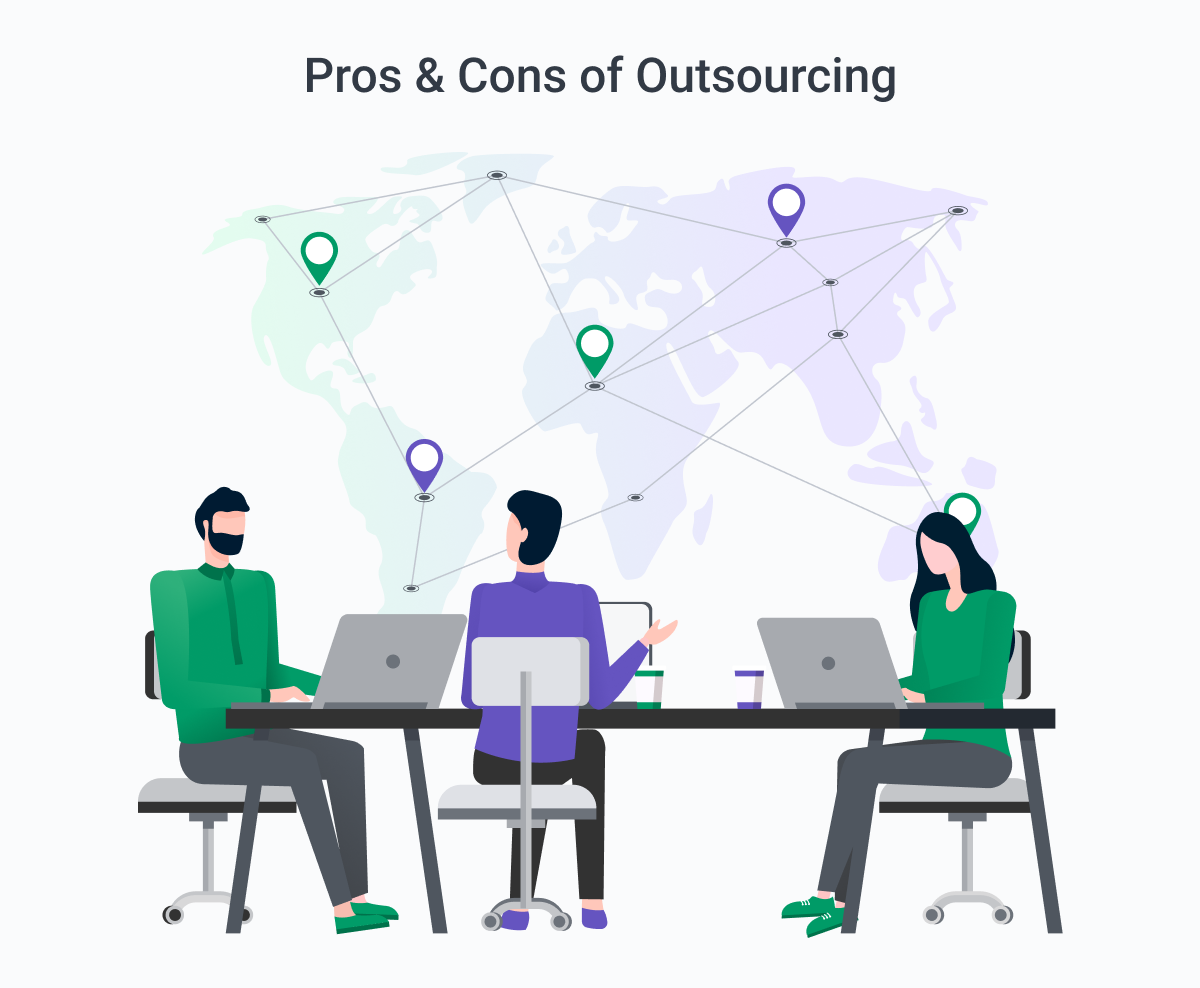In today's globalized business landscape, companies often have the option to outsource certain tasks and projects to other countries - in particular, software development.
According to Statista1, software development accounts for 64% of outsourced services worldwide. The demand for software engineers has doubled since 20202 which is a major reason the global outsourcing market is projected to grow by $40.16 billion by 2025.
Three popular options for outsourcing are offshoring, nearshoring, and onshoring. Each option has its own unique advantages and disadvantages that businesses need to consider when deciding which approach to take.
In this article, we will explore the differences between offshoring, nearshoring, and onshoring, and discuss the pros and cons of each.

Nearshoring vs. Offshoring vs. Onshoring
How is Offshoring Defined?
Offshoring is a type of outsourcing where a company contracts work to be done in a foreign country that is geographically far away. This often involves hiring a development team or a service provider in a different time zone, typically in a country with significantly lower labor costs. The purpose of offshoring is to reduce expenses while tapping into a wider talent pool.
How is Nearshoring Defined?
Nearshoring, on the other hand, is a type of outsourcing where a company contracts work to be done in a neighboring country or a country within close proximity. This usually involves hiring a development team or a service provider in a country that shares a similar time zone or has minimal time zone differences.
Nearshoring offers some of the benefits of offshoring, such as lower costs, while also providing advantages like easier communication and cultural compatibility.
What is Onshoring?
Onshoring, also known as domestic outsourcing, is a type of outsourcing where a company contracts work to be done within its own country. Instead of hiring a development team or service provider abroad, the company chooses to work with local talent.
While it may not provide the cost savings of offshoring or nearshoring, onshoring offers advantages like better control, reduced language barriers, and the ability to support the local economy.

The Pros And Cons of Offshoring
Run Your Business at a Lower Cost
One of the main advantages of offshoring is the potential for significant cost savings - In fact, a 2020 Deloitte study3 found that 70% of companies who choose to outsource their software development projects, do so to save money. Labor costs in offshore locations are often much lower compared to in-house teams or even nearshore options.
Companies can take advantage of this cost difference to run their business more efficiently and allocate resources to other areas. In the same Deloitte study3, it was shown that nearly 40 percent of companies who outsource report savings as high as 40%; the other 60 percent report 10 to 25% savings.
Access to Technology and Experts
The 2020 Deloitte study3 we previously mentioned highlighted cost reduction as the primary motivation behind companies' outsourcing decisions. However, in today's rapidly evolving business landscape, while cost-cutting remains a crucial factor, it now shares the spotlight with other compelling drivers.
A more recent 2022 study performed by Deloitte found that the top reasons that companies outsource are access to new capabilities, the necessity for business model transformations, and the imperative to stay ahead of technology advancements and regulatory changes.
In response, organizations are increasingly relying on the service provider ecosystem to deliver agile and integrated solutions that can help them navigate this complex landscape effectively.
Please accept cookies to access this content
Choose from the Best
Offshoring also allows businesses to tap into a global talent pool. By expanding the search for expertise beyond local borders, companies have access to a wider pool of highly skilled professionals. This offers the opportunity to work with top talent in the industry and access specialized skills that may not be available locally.
Get Work Done While You Sleep
Another advantage of offshoring is the ability to leverage time zone differences. With a development team located in a different time zone, businesses can achieve round-the-clock productivity. Projects can be worked on continuously, with work being handed off from one team to another as the day progresses. This can result in faster development cycles and shorter time-to-market.
The Need for Constant Control
However, offshoring does come with its drawbacks. One major disadvantage is the need for constant control and management. Communication and coordination can become challenging due to distance, cultural differences, and potential language barriers. It requires effective project management and clear expectations to ensure that work is delivered according to the desired standards and timeline.

The Pros And Cons of Nearshoring Teams
Benefit from Geographical Proximity
80% of companies in North America are actively considering nearshore - this is likely because Nearshoring offers businesses the advantage of geographical proximity4.
Working with a nearby country reduces travel time and simplifies communication. This makes it easier to schedule meetings, collaborate on projects, and resolve issues promptly. Plus, the close proximity means that teams can work in similar time zones, ensuring real-time collaboration and better coordination.
Closer Cultural Compatibility
Nearshoring also provides a higher degree of cultural compatibility compared to offshoring. Neighboring countries often share similar cultural values, work ethics, and business practices.
This aids in fostering stronger working relationships, better understanding, and smoother collaboration between teams. Cultural similarities can contribute to increased efficiency and reduced misunderstandings.
Poor Selection
On the downside, nearshoring may have limitations in terms of the available talent pool. Neighboring countries may not offer the same breadth and depth of expertise as offshore locations with larger populations. Therefore, companies that require highly specialized skills or niche expertise may face limitations when nearshoring.
The Pros and Cons of Onshoring Teams
You can Find Cheaper Options
One major advantage of onshoring is the potential to find cheaper options within your own country. While it may not offer the extreme cost savings of offshoring, there might be regions or cities within your country where the labor costs are significantly lower than in major metropolitan areas. By exploring different regions, you can potentially find cost-effective options while still supporting the local economy.
Invest in Your Country
By choosing onshoring, businesses can directly support and invest in their own country's economy. This can be particularly appealing for companies that prioritize corporate social responsibility and want to contribute to local development and job creation. Onshoring also reduces the risk associated with international business, such as changes in political climate or economic instability in foreign countries.
Arm Yourself with Patience
However, onshoring can come with challenges, such as higher labor costs compared to offshore and nearshore options. Companies also need to consider the availability of talent within their own country and potential competition from other businesses. Depending on the location, finding highly specialized skills or niche expertise may still be challenging, requiring patience and thorough research.
Choosing the Right Outsourcing Model
Choosing between onshore, nearshore, and offshore outsourcing is a strategic decision that depends on a company’s specific needs, budget, and priorities. While onshore and nearshore options may offer more straightforward communication and cultural alignment, offshore options often provide significant cost savings.
The best outsourcing model depends on project requirements, budget, and scope. While offshoring offers cost benefits, onshoring provides ease of collaboration. Nearshoring strikes a balance between the two. Some companies even adopt a hybrid approach, utilizing multiple models for different project aspects.
While choosing the best model is important, we strongly encourage companies to conduct research about their own goals and about the third-party companies they are considering working with.
Things to consider are gaining a good understanding of your own business and software development needs, and the experience, reputation, and industry expertise of each potential outsourcing partner, check out our full guide about successfully outsourcing software development for more tips and guidance.

The Best Countries to Outsource to?
When it comes to outsourcing software development, Eastern Europe has emerged as a popular choice for many companies. The region offers a rich talent pool, competitive labor costs, and a high level of technical expertise. By partnering with a service provider in Eastern Europe, businesses can leverage these advantages and achieve their development goals effectively.
Eastern Europe, particularly Ukraine, is emerging as a hub for software development. Even with the war, in 2023 Ukraine is trusted by one in five Fortune 500 Companies for their software development needs5. With a growing number of IT professionals, Ukraine offers:
- High-quality software talent.
- Competitive development costs.
- Strong English proficiency.
- Strategic location in Europe and adherence to EU regulations.
Need to Scale Your Team?
If you want to scale your team, whether through offshoring or nearshoring, consider partnering with a reliable outsourcing service provider, like Softjourn. We can help you navigate the outsourcing landscape, find the best R&D talent, and ensure a smooth and successful collaboration. Whether you're exploring offshore development, nearshore outsourcing, or even consulting services, our expertise in offshoring and nearshoring can make all the difference.
Contact us today to discover the advantages of offshore and nearshore outsourcing and find the right outsourcing model for your project's success. Your next development milestone is just a click away!

Choose the Right Outsourcing Model
When choosing the right outsourcing option, it's essential to weigh the pros and cons of offshoring, nearshoring, and onshoring. Each option offers unique benefits and trade-offs.
Offshoring provides significant cost savings and access to a global talent pool but requires careful management and communication. Nearshoring offers geographical proximity and cultural compatibility but may have limitations in terms of the talent pool. Onshoring supports the local economy but may come with higher labor costs.
No matter which model you choose, the most important aspect will be ensuring you choose the right third-party partner. Ultimately, the decision depends on the business's specific needs and priorities.















